Article and photos by Joe Mish

My South Branch office is made of kevlar and weighs 52#, well lit with natural light and leaves no trace. A perfect vehicle for discovering New Jersey’s natural treasure hidden in plain view.
Every once in a while, it is useful to check your back trail to validate your current course. For the last few years I have been attending the Rutgers sponsored, ‘Annual Sustainable Raritan River Conference’ and was introduced to the people and effort dedicated to improve the water and land that make up the Raritan River basin.
It was strange at first to hear someone else talk about my river. There was a moment of concern, a tinge of jealousy, that my ownership of the river was being usurped by strangers, some not even native to New Jersey. I soon realized I was among kindred spirits. It was like meeting long lost relatives….. whose company you sincerely enjoyed. Each member contributed a critical piece of the puzzle, whether a citizen, volunteer or a degreed scientist, each perspective complimented the other, and occasionally there was the discovery of a piece no one knew was missing. The symposium took the threads of individual effort and wove them into a whole cloth.
I was pleasantly surprised, the focus of the conference dovetailed perfectly into my goals and objectives. It also prompted me to revisit what I hope to accomplish with my images and words, given the current status of New Jersey’s relationship with its natural treasures.
Today New Jersey enjoys a natural inheritance that is the sum of the legacy left by generations of agrarian, industrial and residential development. Sacrificed in the name of progress, our natural and wild treasures are reputed to have been diminished to a vanishing point in the wake of the great human juggernaut. However, despite New Jersey’s recurring reputation as the most densely populated state in the union, wildlife is found to proliferate along its river corridors, highways, woods and fields. Much of this wildlife existed before the establishment of farms, whose disappearance falsely signals the surrender to unabated construction and development. The farms and cows are actually late-arriving interlopers, highly visible and used as a convenient but inaccurate measure of our intrinsic wild and natural resources. It is the presence or absence of cows that form the basis for politically subjective land use decisions.
Even the most ardent nature-oriented residents are often oblivious to the richness and distribution of this state’s natural treasures. Regional areas, reputed as nature destinations, add to obscure our natural treasures as their existence implies an absence of nature except where designated. Combine this with the perspective of the nature-neutral and nature-oblivious residents and it is understandable how the nature sterilized image of New Jersey arises from within and grows with distance to earn a national and global reputation as “the ghost of nature past”.
Against this background my photographic intentions range from historic documentation of ephemeral wild moments to portraiture revealing the energy and dignity of the creatures that covertly exist among us. What the camera misses the words capture, what the camera sees the words enhance.
The articles are a blend of literary flourish embedded with scientific information as much for entertainment as to arouse curiosity. I wish to create a gravitational pull of curiosity that draws the reader to seek deeper knowledge. Hopefully some youngster will be intrigued enough to pursue more detailed information and perhaps launch a career in science.
One reason New Jersey’s natural treasures remain hidden in plain view is because of prejudice and limited expectation. The best way to remedy this, is to change the lens through which our natural world is viewed. I do this by presenting stories and information from unique perspectives, along with images of wildlife most have never seen and many more don’t believe exist so close to home.
When I consider my place in the effort to restore the rivers, I see me operating on the interface between art and science. I walk that line to help transition attitudes and open eyes to a new reality fostered by creativity and imagination.
Rutgers fish camera at Island Weir Dam on the Raritan River is now online.
http://raritanfishcam.weebly.com
Author Joe Mish has been running wild in New Jersey since childhood when he found ways to escape his mother’s watchful eyes. He continues to trek the swamps, rivers and thickets seeking to share, with the residents and visitors, all of the state’s natural beauty hidden within full view. To read more of his writing and view more of his gorgeous photographs visit Winter Bear Rising, his wordpress blog. Joe’s series “Nature on the Raritan, Hidden in Plain View” runs monthly as part of the LRWP “Voices of the Watershed” series. Writing and photos used with permission from the author.
Article and photos by Joe Mish
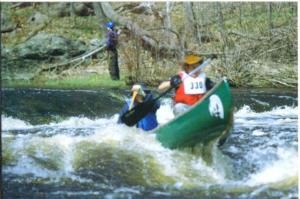
The powerful watery hand of the river reaches up in a wild mood to toss its dance partner skyward.
A canoeist might think of the river as a dance partner whose energy flow and mood sets the tone for the style of dance to be performed. A waltz, a tango or lambada are all on the river’s dance card to be enjoyed or sat out. Any paddler who wishes to partner with the river and enjoy the wide variety of watery tunes must have practiced moves, familiarity with boat and paddle and an ability to read the subtle nuance of wave patterns reflecting the structure of the hidden riverbed.
While high water and low water dances may be thoroughly enjoyed, I originally coined the term ‘river dance’ to describe the convoluted navigation required to follow the low water flow typically occurring on the South Branch during the summer.
Each year, winter ice and downed trees reshape the river bed to form new shoals, islands and channels which leave the scars and wrinkles that figure so prominently when water levels drop in the summer.
Low water and limited paddler skill do not preclude a float trip down the river as a grounded boat may be dragged across exposed shoals and shallows to deeper water.
Plodding along does not equate to river dancing but it gets the job done.
The joy of river dancing comes into play when the paddler, perhaps in a solo canoe, seeks out cuts and channels that hold just enough water to support the boat. Following the deepest water when the riverbed becomes a player in the band may mean tracing a convoluted course from one side of the river to the other. This shallow water navigation strategy is directly applicable to high, fast water flowing through boulder strewn stretches of river. Both situations require reading the wave patterns to determine the best path beyond the next immediate move.
One fast water section where I launch always has sufficient water from bank to bank for about a hundred yards. During lower water levels the left side and most of the middle of the riverbed is almost exposed and not navigable except for a narrow cut quite close to river right. As is often the case, a direct downstream approach to the deep water cut is not possible because the water directly above the cut is too shallow or has a downed tree blocking that approach. As the situation and solution is obvious from a long distance upstream there is time to gradually approach the passage at a forty-five degree angle and then straighten the boat with a quick draw to follow perfectly in the strong deep current.
Further downstream near a bend in the river, a long treeless island appears, the right side of which is navigable in a channel that runs along the opposite bank. As the channel nears the end of the island, it flattens out and disappears. The water then seeks to run at an angle across the raised center section of the riverbed. The riverbed here appears to have a profile of a typical crowned roadway and the main channel reappears to run just along the tip of the island. Crossing the riverbed from one channel to the other requires a good look at the wave patterns. If you know nothing, then just observe the differences in the wave patterns. In very shallow water they are almost indistinguishable but with practice differences will become apparent. Generally, flatter waves reflect deeper water. Or simply put, the less busy the surface of the water appears, the further above the riverbed it is. Don’t be surprised sometimes to find the water too shallow despite choosing the most favorable pathway. Crossing an ultra shallow channel as described, may require the paddler to shift their weight forward to create an absolute neutral balance in the boat to avoid a fore or aft drag. Shifting paddler weight to one side in a typical shallow V-shaped hull will often decrease the depth the hull protrudes into the water and might make the difference between stepping out and dragging the boat or barely floating by with some slight scraping.
One of the most useful skills a paddler can acquire is the ability to ferry. A ferry is a method which allows cross stream travel in swift water with minimal paddler effort.
I usually stop to do a ferry whenever fast water presents itself just because it is so much fun and feels like magic. A ferry is based on the premise that a canoe becomes invisible to the current when perfectly aligned with the water flow. A canoe can be paddled upstream and held in position without any downstream travel when the hull is parallel to the water flow. Eventually when the hull begins to angle across the current the boat will be washed downstream. The speed with which the boat is carried downstream depends on the angle of the boat to the water flow. The greater the hull angle, the greater the surface area the current has to push against. A ferry is possible when the boat is angled into the current and that angle held steady by the paddler. Very fast water requires a shallow angle to be held, the slower the water speed the greater the angle needed to perform a ferry.
Often the current speed changes as you cross the river and the boat’s position must be adjusted appropriately. The magic occurs when you realize the boat, held at the proper angle, begins to cross the current from one side to the other without any downstream travel!
A ferry can be accomplished with the bow upstream or downstream. Simply angle the upstream end of the boat in the direction of the shore you wish to reach. In very fast water you might suddenly find yourself at the precipice of a ledge with no chance of safe passage. Not to worry. Straighten the hull with any and all paddle strokes that might be applicable, hold the boat steady. Choose your angle and be amazed as your boat becomes a magic carpet to drift you above the ledge, perpendicular to the current, and on to a safe passage or convenient eddy.
Do not despair when summer water levels fall and most folks abandon the thought of paddling the local rivers. Armed with patience and agility you might try to dance with the river on her terms.
Author Joe Mish has been running wild in New Jersey since childhood when he found ways to escape his mother’s watchful eyes. He continues to trek the swamps, rivers and thickets seeking to share, with the residents and visitors, all of the state’s natural beauty hidden within full view. To read more of his writing and view more of his gorgeous photographs visit Winter Bear Rising, his wordpress blog. Joe’s series “Nature on the Raritan, Hidden in Plain View” runs monthly as part of the LRWP “Voices of the Watershed” series. Writing and photos used with permission from the author.
On Saturday May 5 several partners helped the Borough of Bound Brook inaugurate its first kayak/canoe launch site. A partnership between the Borough and New Jersey American Water (NJAW) resulted in an access agreement to allow recreational use of private land, giving paddlers a new access point to the Raritan River. The agreement between the Borough and NJAW allows the public to put their watercraft into the Raritan in an area owned by NJAW under the Queens Bridge in the Borough.
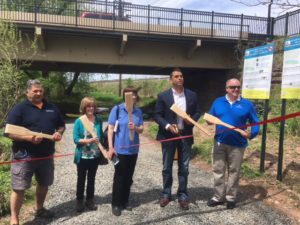
Bound Brook Borough Administrator Hector Herrera and Council President Abel Gomez were joined by representatives of South Bound Brook; Somerset County; New Jersey American Water; Pfizer on behalf of Wyeth Holdings; the Raritan Riverkeeper; National Park Service Rivers, Trails & Conservation Assistance; and members of the public for the ribbon cutting and launch ceremony on a beautiful spring day. Signs explaining how to use the access site with a map of downtown Bound Brook greeted launch users in English and Spanish.
Council President Abel Gomez noted: “This launch site for kayaks and canoes is part of a bigger plan to restore public access to the Raritan River. In 2015, the Borough’s Economic Development Advisory Committee published Riverfront Access Plan for Pedestrians and Bicyclists. This plan puts forth strategy and initiatives for a comprehensive bicycle and pedestrian network to connect downtown commercial areas with the riverfront. The launch site is another element that makes Bound Brook a destination area.”
In addition to the access to the River for paddlers, the Plan calls for the creation of a park along the waterfront from Queens Bridge to Middle Brook, including the development of a riverfront trail system for pedestrians and bicyclists using inactive rail corridor and a levee system. Raritan Riverkeeper Bill Schultz explained that the “launch site will mean that paddlers can now travel all the way from Bound Brook downstream to Perth Amboy and the Raritan Bay, about 18 miles. Raritan River recreation complements the land-based recreation currently available on the south side of the river, as part of the Delaware & Raritan Canal State Park.”
The Borough is receiving technical assistance from the National Park Service’s Rivers, Trails & Conservation Assistance Program. The NPS helped form a steering committee made of local stakeholders, including New Jersey American Water, Somerset County Planning Division, Rutgers University Edward J. Bloustein School of Planning and Public Policy, Pfizer on behalf of Wyeth Holdings, and members of the Bough’s Economic Development Advisory Committee.
The Riverfront Access Plan is available at: http://boundbrooknj.org/MasterPlan/RiverAccessPlan
For more information about the project, contact Bound Brook Borough Administrator
Hector Herrera at 732-893-8520 or hherrera@boundbrook-nj.org
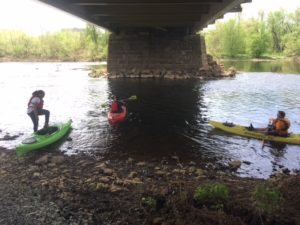
Article and photo by Hector Herrera
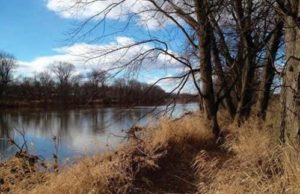
A partnership between the Borough of Bound Brook and New Jersey American Water will give kayak and canoe enthusiasts a new access point to the Raritan River. The agreement between the Borough and New Jersey American Water allows the public to put their watercraft into the River in an area owned by NJAW under the Queens Bridge in the Borough.
“This launch site for kayaks and canoes is part of a bigger plan to restore public access to the Raritan River. In 2015, the Borough’s Economic Development Advisory Committee published Riverfront Access Plan for Pedestrians and Bicyclists,” said Bound Brook Council President Abel Gomez.
“This plan puts forth strategy and initiatives for a comprehensive bicycle and pedestrian network to connect downtown commercial areas with the riverfront. This launch site is another element that makes Bound Brook a destination area.”
In addition to the access to the River for kayaks and canoes, the Plan calls for an open space along the waterfront, from Queens Bridge to Middle Brook. This would include the formalization of a Bound Brook Riverfront Trail System for pedestrians and bicycles and a creation of a riverfront park. The Plan can be found by going to this url: http://boundbrook-nj.org/MasterPlan/RiverAccessPlan
The Borough received a technical assistance award from the National Park Service’s Rivers, Trails & Conservation Assistance Program in 2017 and 2018. The NPS helped form a steering committee made of local stakeholders including New Jersey American Water, Somerset County Planning Division, Rutgers University Edward J. Bloustein School of Planning and Public Policy, Pfizer, and members of the Borough’s Economic Development Advisory Committee.
The Borough of Bound Brook and New Jersey American Water will formally open Bound Brook’s Riverfront Access Launch at noon on Saturday, May 5, 2018. The launch is located under the Queens Bridge in Bound Brook. RSVP required.
For more information about the kayak and canoe launch site or to RSVP for the ribbon cutting ceremony, contact Bound Brook Borough Administrator Hector Herrera 732-893-8520.
Article and photos by Joe Mish
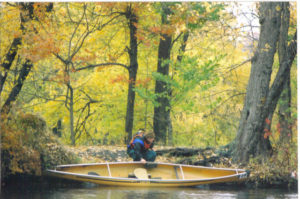
A yellow, curled up autumn leaf or a Kevlar canoe, both are more than capable of transporting a traveler and their imagination through the autumn scenery along the South Branch of the Raritan and reveal a glimpse of the hidden, natural world.
The early morning October sun shown through the amber hull of my Kevlar canoe to resemble a bright yellow leaf with curled up edges that fell gently upon the water’s surface. It is easy to imagine sitting in that curled leaf, high and dry, while riding the river’s swirling currents. Witness the secret world of nature that shies away from sound and movement as you silently drift downstream. The leaf provides a cloak of near invisibility as you now become a spirit on a journey through the physical world.
I set my Kevlar leaf upon the water and settled in to the sliding bucket seat with my hips and knees braced against the gunnels and held in place by the foot brace. I was now an integral part of the canoe, my slightest movement instantly transmitted to the hull. A single paddle stroke turned the bow into the current which magically spun the boat and took it downstream. A draw stroke and a shift in weight against the hull and was enough to direct my yellow leaf on a journey thru the October scenery along the South Branch.
This morning, the brilliance of autumn foliage was muted by a fine mist rising from the river. Shafts of sunlight, however, gave a preview of the colors soon to be unveiled as the mist gave way to the bright, clear fall day.
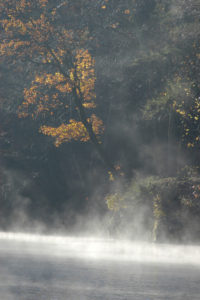
I soon spotted a pair of wood ducks nervously swimming in circles in an eddy downstream of a fallen tree. To get as near as possible for a photo, I kept the paddle in the water opposite the side of the ducks and used a figure eight movement to propel and steer the boat into position for the best camera angle.

The boat drifted quite close before the pair of woodies flew off; when disturbed, they make an unmistakable, repetitive, two tone alarm call. The fast action framed by autumn color and blue sky, was over in seconds as the echo of their calls faded in the distance.
What remained was an indelible image of these little birds gaining flight so quickly and flying full speed between the drape of overhanging branches, covered with orange leaves, and the calm reflective water of the eddy.
Though a diminutive bird, the full range of motion of its wings barely cleared the passage between the trees and water. The tip of the longest flight feather, almost imperceptibly, left marble sized imperfections in the mirrored surface with each wingbeat as the birds disappeared in the distance around the curved riverbank.
The river then straightened out to provide a wide angle perspective spreading out before me. The trees on either bank were ablaze in yellow, orange, red and scarlet, the color intensified by the position of the sun and a near cloudless sky of the brightest sky blue you can imagine. A rare white fluffy cloud, low on the horizon, stood in stark contrast against the celestial blue concentrate. To behold such a bucolic scene while riding on a magic carpet suspended on a river of energy within a kaleidoscope of color, mind and body enjoy a brief respite from thought, time and place.
Several more miles downstream, my curled yellow leaf followed a deep channel along the high, red shale riverbank that gently curved to the left. The water, here, expressed deliberate intent as its energy flowed fast, allowing me to remain almost motionless. The hydraulic backwash on either side of the narrow channel kept the boat centered with minimal intervention from my paddle.

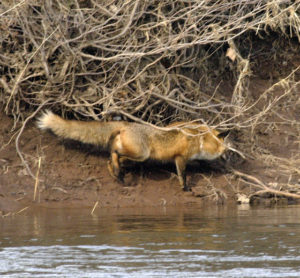
Ahead, a red fox walked along the steep bank at the water’s edge, apparently preoccupied with maintaining its footing. The angle of my approach and wind direction helped cover my scent and sound, allowing the fox to remain undisturbed. When I felt the fox’s field of vision was momentarily diverted, I would make a forceful paddle stroke to close the distance. Unbelievably, I was able to drift up behind and to the right of the distracted fox. After several photos the fox realized it was exposed and tried to escape up and over the vertical bank. In its haste, the fox slipped and almost fell into the river. Momentarily stunned by the unexpected action and the current’s demand for immediate attention, the fox’s embarrassing moment was safe from digital publication.
As a passenger on an imaginary floating autumn leaf, carried along by the energy of moving water, the next stop could be anywhere in the world where the sweet water of the South Branch flows. I chose, however, to get off in an overgrown pasture resplendent in autumn color, my yellow leaf turning back into a Kevlar canoe and a quarter mile uphill portage for which I had to supply the energy.
Author Joe Mish has been running wild in New Jersey since childhood when he found ways to escape his mother’s watchful eyes. He continues to trek the swamps, rivers and thickets seeking to share, with the residents and visitors, all of the state’s natural beauty hidden within full view. To read more of his writing and view more of his gorgeous photographs visit Winter Bear Rising, his wordpress blog. Joe’s series “Nature on the Raritan, Hidden in Plain View” runs monthly as part of the LRWP “Voices of the Watershed” series. Writing and photos used with permission from the author.










